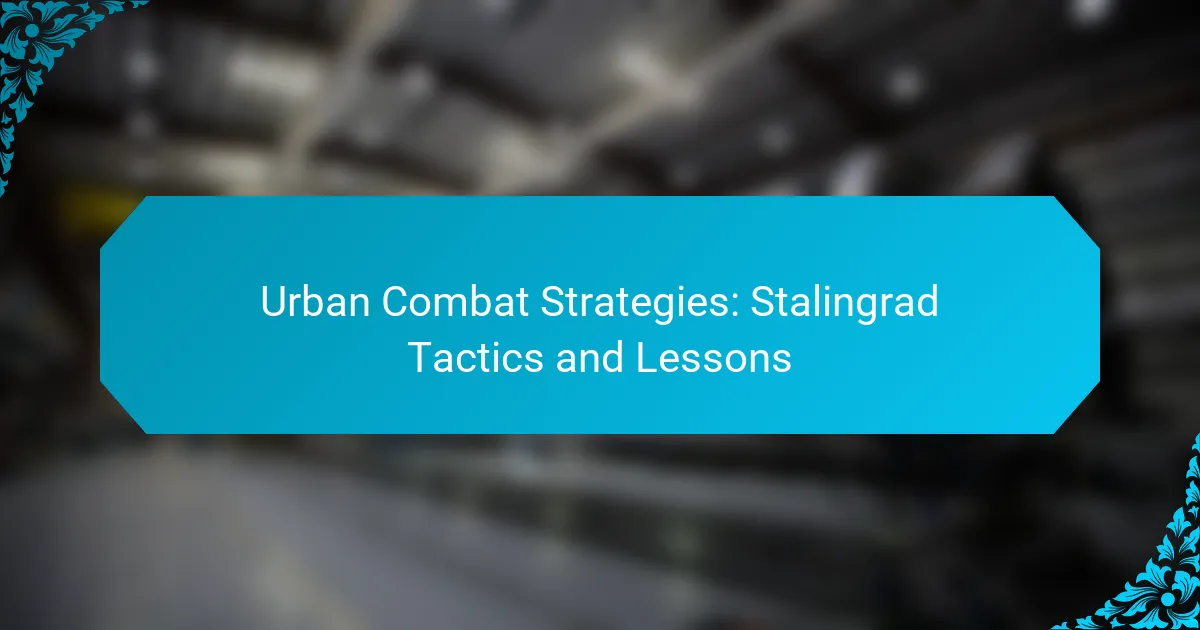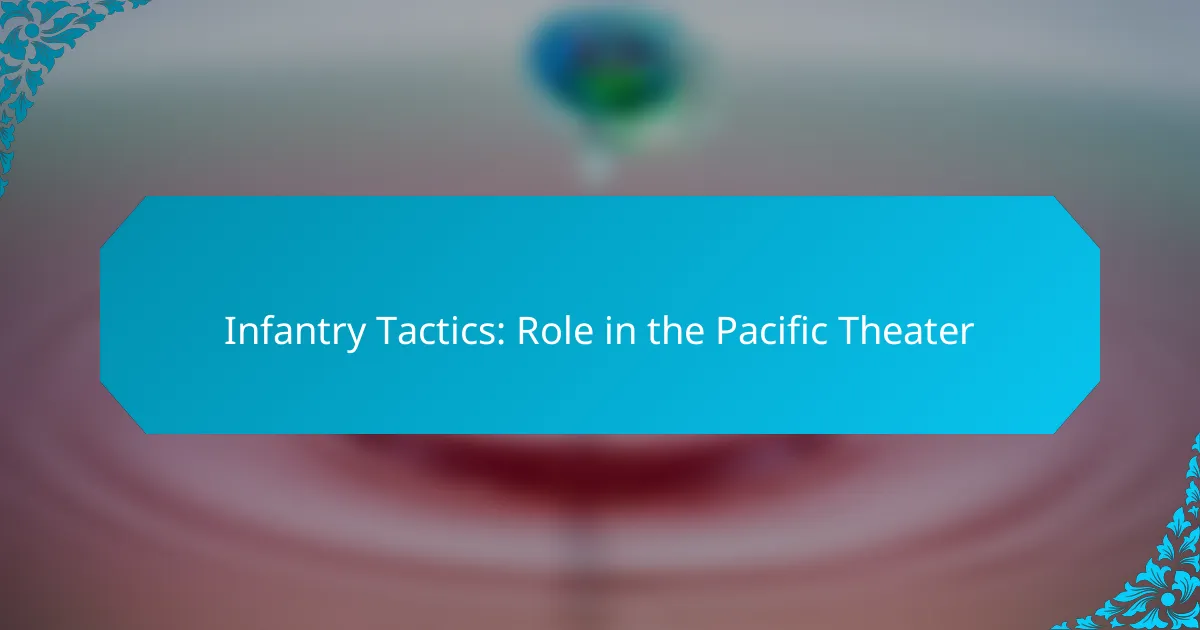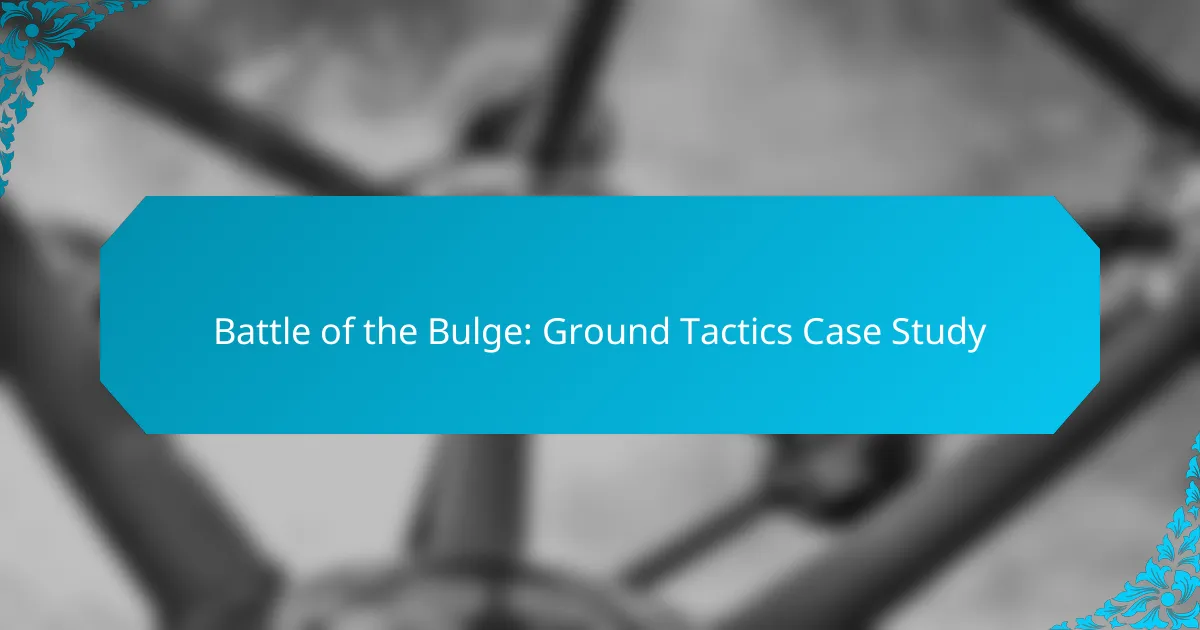The Battle of Stalingrad serves as a critical case study in urban combat strategies, showcasing the effectiveness of maneuver warfare, defensive strongpoints, and close-quarters combat techniques. The lessons learned from this pivotal conflict emphasize the importance of logistics, adaptability, and the integration of various military elements in densely populated environments. These insights continue to shape contemporary military tactics and planning for urban warfare.

What Are Key Urban Combat Strategies from Stalingrad?
Key urban combat strategies from Stalingrad include maneuver warfare, establishing defensive strongpoints, effectively using terrain, mastering close-quarters combat techniques, and employing psychological warfare. These tactics were crucial for both offensive and defensive operations in a densely populated urban environment.
Urban maneuver warfare
Urban maneuver warfare focuses on rapid movement and adaptability within city landscapes. Forces must leverage buildings and streets for cover while maintaining the ability to shift positions quickly to exploit enemy weaknesses. This approach often requires small, agile units capable of executing flanking maneuvers and ambushes.
Effective urban maneuvering involves understanding the layout of the city, including potential choke points and escape routes. Commanders should prioritize reconnaissance to gather intelligence on enemy positions and civilian infrastructure, which can be used to their advantage.
Defensive strongpoints
Defensive strongpoints are fortified positions that provide cover and control over key areas. In Stalingrad, buildings were often repurposed into strongholds, allowing defenders to create layers of defense. Establishing these strongpoints requires careful selection of locations that offer visibility and protection.
To maximize effectiveness, strongpoints should be interconnected, allowing for mutual support between units. Regular resupply and reinforcement are crucial to maintaining these positions, as prolonged engagements can lead to attrition and diminished combat effectiveness.
Use of terrain
Utilizing terrain effectively is vital in urban combat, as it can significantly influence the outcome of engagements. In Stalingrad, fighters took advantage of rubble, ruins, and natural obstacles to create barriers against enemy advances. Understanding the terrain allows for better planning of both offensive and defensive operations.
Forces should assess the urban landscape for advantageous high ground and cover. Utilizing natural and man-made features can enhance concealment and provide strategic advantages during combat. Training troops to navigate and exploit terrain is essential for success in urban warfare.
Close-quarters combat techniques
Close-quarters combat techniques are essential in urban environments where engagements often occur at short distances. Techniques such as room clearing, use of hand grenades, and close-range firearms training are critical for survival and effectiveness in these scenarios. Soldiers must be trained to engage quickly and decisively.
Incorporating teamwork and communication is crucial during close-quarters encounters. Units should practice drills that emphasize coordination and situational awareness to minimize friendly fire and maximize combat effectiveness in confined spaces.
Psychological warfare
Psychological warfare plays a significant role in urban combat by aiming to undermine the enemy’s morale and will to fight. Tactics can include propaganda, disinformation, and demonstrations of force to create fear and confusion among opposing forces. In Stalingrad, psychological tactics were used to exploit the harsh conditions and high casualties faced by the enemy.
Effective psychological operations require understanding the cultural and social dynamics of the urban population. Engaging with civilians can provide valuable intelligence and support, while also fostering an environment that demoralizes the enemy. Building a narrative that highlights victories and resilience can further bolster morale among friendly forces.
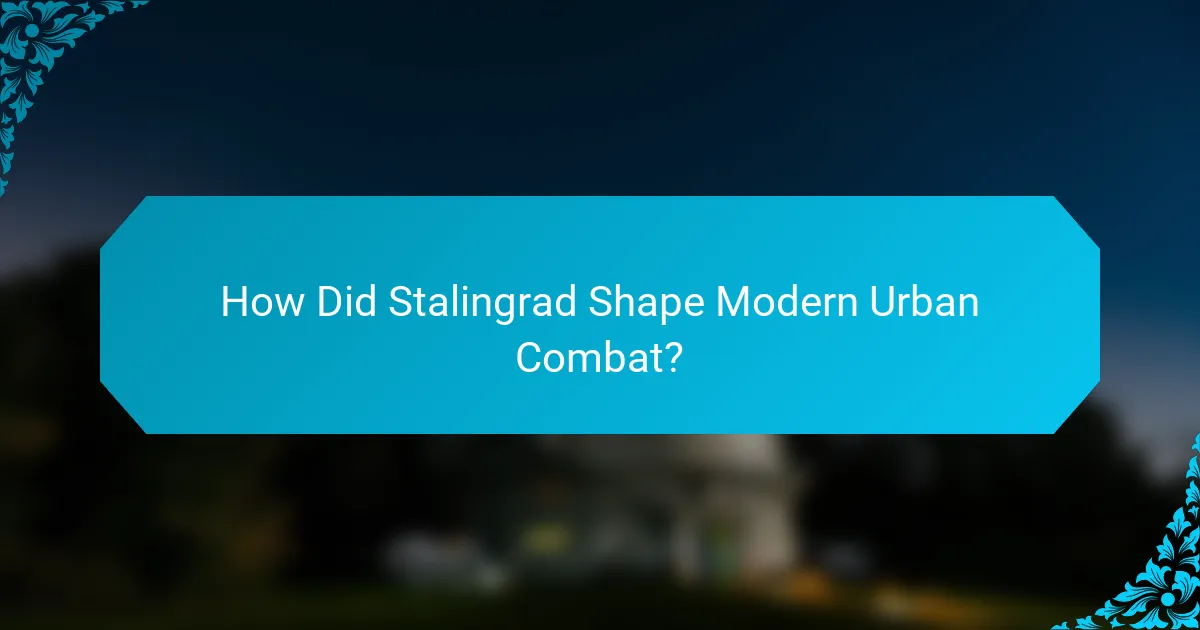
How Did Stalingrad Shape Modern Urban Combat?
The Battle of Stalingrad fundamentally transformed urban combat strategies by highlighting the significance of logistics, infrastructure, and adaptability in city warfare. The lessons learned from this pivotal conflict continue to influence military tactics and planning in contemporary urban environments.
Lessons in logistics
Stalingrad underscored the critical role of logistics in sustaining military operations. Supply chains must be robust and flexible, capable of adapting to rapidly changing conditions on the battlefield. Effective management of resources, including food, ammunition, and medical supplies, can determine the outcome of urban engagements.
For modern forces, establishing secure supply routes and utilizing local resources can enhance operational efficiency. Regular assessments of supply needs and potential bottlenecks are essential to maintain momentum in urban combat scenarios.
Importance of civilian infrastructure
The battle demonstrated how civilian infrastructure can be both an asset and a liability in urban warfare. Buildings, roads, and utilities can provide cover and strategic advantages, but they can also become targets, complicating humanitarian efforts. Understanding the layout and functionality of urban spaces is crucial for military planning.
Modern militaries should prioritize the protection of civilian infrastructure to minimize collateral damage and maintain public support. Engaging with local communities can facilitate better intelligence and cooperation, ultimately leading to more effective operations.
Adaptation to urban environments
Stalingrad highlighted the need for forces to adapt their tactics to the unique challenges of urban environments. Close-quarters combat, the use of snipers, and the importance of reconnaissance are all critical elements that emerged from this battle. Flexibility in tactics allows for quick responses to evolving threats.
Training for urban combat should include simulations that replicate the complexities of city fighting, emphasizing teamwork and communication. Utilizing technology, such as drones for surveillance and mapping, can enhance situational awareness and improve decision-making in urban settings.
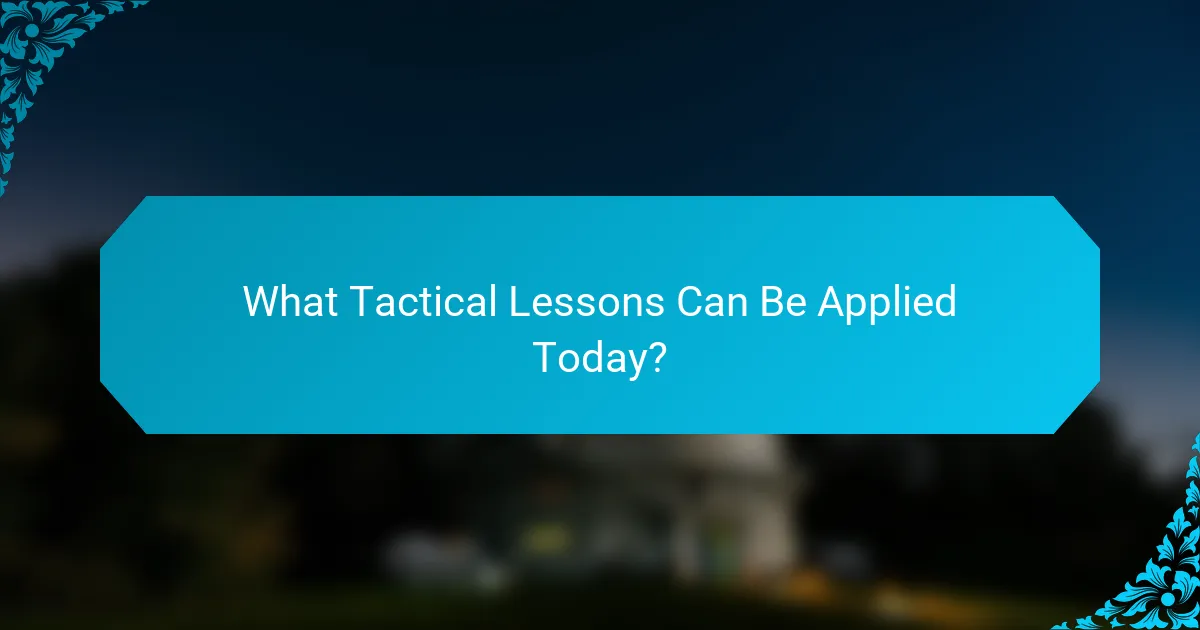
What Tactical Lessons Can Be Applied Today?
Tactical lessons from the Battle of Stalingrad emphasize the importance of integrating various military elements, gathering intelligence, and employing effective camouflage in urban environments. These strategies can enhance modern urban combat operations by improving coordination and adaptability.
Combining infantry and armor
Combining infantry and armor is crucial for effective urban combat. Infantry units provide essential support for armored vehicles, allowing them to navigate complex terrains while protecting flanks and engaging enemies in close quarters. This synergy can significantly enhance combat effectiveness.
For instance, deploying infantry to clear buildings before tanks advance can reduce the risk of ambushes. A common tactic is to use infantry to scout ahead, ensuring armored units can move safely through urban landscapes. Coordination between these forces is vital; regular communication and joint training exercises can improve this integration.
Intelligence and reconnaissance
Intelligence and reconnaissance are foundational to successful urban operations. Gathering accurate information about enemy positions, movements, and local terrain allows commanders to make informed decisions. Utilizing drones and surveillance teams can enhance situational awareness in densely populated areas.
Effective reconnaissance should include both visual and electronic intelligence. Regularly updating intelligence reports can help adapt tactics to changing conditions. A practical approach is to establish a network of informants and utilize technology to monitor enemy activities, ensuring a comprehensive understanding of the battlefield.
Urban camouflage techniques
Urban camouflage techniques are essential for concealing forces and equipment in city environments. Effective camouflage can reduce visibility and enhance survivability, allowing troops to operate without detection. Techniques may include using local materials to blend in with surroundings or employing digital patterns that disrupt outlines.
For example, vehicles can be painted in colors that match the urban landscape, while soldiers might wear uniforms that mimic the textures and colors of buildings. Training in these techniques is crucial; units should practice setting up concealment quickly and effectively to adapt to different urban settings.
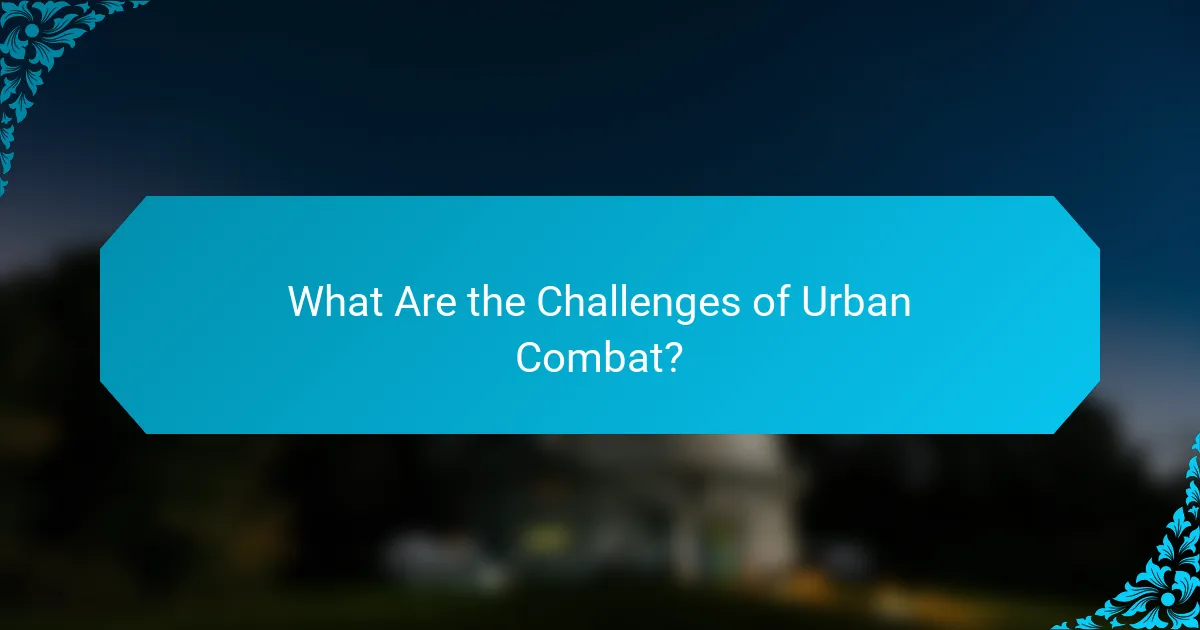
What Are the Challenges of Urban Combat?
Urban combat presents unique challenges that can significantly impact military operations. Factors such as limited visibility, civilian presence, and complex terrain navigation complicate tactical decisions and require specialized strategies.
Limited visibility
In urban environments, visibility is often restricted due to buildings, debris, and other obstacles. This can hinder situational awareness and make it difficult for soldiers to identify threats or targets.
To mitigate visibility issues, forces should use advanced reconnaissance techniques and technology, such as drones or thermal imaging. Establishing clear communication protocols is also essential to share information about enemy positions and movements effectively.
Civilian presence
The presence of civilians in urban combat zones poses significant ethical and tactical challenges. Engaging in combat while ensuring civilian safety requires careful planning and restraint.
Military units must prioritize intelligence gathering to distinguish between combatants and non-combatants. Rules of engagement should be clearly defined, emphasizing the importance of minimizing civilian casualties to maintain local support and legitimacy.
Complex terrain navigation
Urban landscapes feature intricate layouts, including narrow streets, multi-story buildings, and hidden pathways, complicating movement and maneuverability. This complexity can lead to ambushes and surprise attacks.
To navigate effectively, troops should conduct thorough terrain analysis and utilize maps or GPS systems. Training in urban warfare tactics, such as room clearing and close-quarters combat, is crucial for adapting to the challenges posed by complex environments.

How to Train for Urban Combat Scenarios?
Training for urban combat scenarios involves a combination of realistic simulations, specialized drills, and collaboration with local forces. These elements help prepare military personnel for the unique challenges presented by urban environments, such as close quarters, limited visibility, and civilian presence.
Live-action simulations
Live-action simulations are critical for training in urban combat, providing a realistic environment where soldiers can practice tactics and decision-making under pressure. These simulations often involve role-playing scenarios that mimic real-life situations, allowing participants to engage in combat scenarios that require quick thinking and adaptability.
To maximize effectiveness, simulations should include various urban settings, such as residential areas, commercial districts, and industrial zones. Incorporating elements like noise, smoke, and civilian actors can enhance realism and prepare troops for the unpredictability of actual combat.
Urban warfare drills
Urban warfare drills focus on specific skills needed for combat in city environments, such as room clearing, building entry, and hostage rescue. These drills should be conducted regularly to build muscle memory and ensure that soldiers can execute tactics efficiently under stress.
Drills can be structured in phases, starting with individual skills and progressing to team-based exercises. Incorporating feedback and after-action reviews helps identify areas for improvement and reinforces learning outcomes.
Collaboration with local forces
Collaborating with local forces is essential for effective urban combat training, as it fosters understanding of the local environment and cultural dynamics. Joint exercises with local law enforcement or military units can provide insights into community relations and operational tactics that are specific to the area.
Such collaboration can also enhance intelligence sharing and improve situational awareness, which is crucial for minimizing civilian casualties and ensuring mission success. Establishing strong relationships with local forces can lead to more effective operations and better outcomes in urban combat scenarios.

What Role Does Technology Play in Urban Combat?
Technology significantly enhances urban combat by improving situational awareness, communication, and operational efficiency. Tools such as drones, surveillance systems, and advanced weaponry allow forces to navigate complex environments more effectively and respond to threats with greater precision.
Drones for reconnaissance
Drones are essential for reconnaissance in urban combat, providing real-time aerial views of the battlefield. They can scout enemy positions, identify potential ambush sites, and assess damage, all while minimizing risk to personnel.
When deploying drones, consider factors like battery life, range, and payload capacity. Most tactical drones operate within a range of 5 to 10 kilometers and have flight times of 20 to 40 minutes, which is generally sufficient for urban surveillance missions.
To maximize effectiveness, ensure drones are equipped with high-resolution cameras and thermal imaging capabilities. Avoid common pitfalls such as flying drones in adverse weather conditions or over heavily populated areas without proper authorization, as this can lead to mission failure or civilian casualties.
